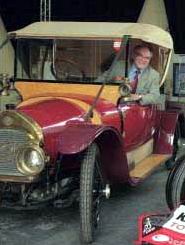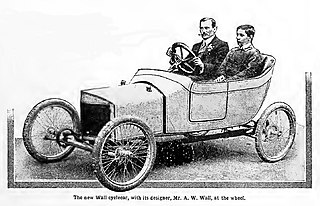
The Alcyon was a French bicycle, automobile and motorcycle manufacturer between 1903 and 1954.
Coventry Victor was a British motorcycle and car manufacturer. Originally Morton & Weaver, a proprietary engine manufacturer in Hillfields, Coventry, founded in 1904, the company changed its name to Coventry Victor Motors in 1911. The company closed in 1971.

L'Aster, Aster, Ateliers de Construction Mecanique l'Aster, was a French manufacturer of automobiles and the leading supplier of engines to other manufacturers from the late 1890s until circa 1910/12. Although primarily known as an engine mass manufacturer the company also produced chassis for coach-works and a complete range of components.

Singer Motors Limited was a British motor vehicle manufacturing business, originally a bicycle manufacturer founded as Singer & Co by George Singer, in 1874 in Coventry, England. Singer & Co's bicycle manufacture continued. From 1901 George Singer's Singer Motor Co made cars and commercial vehicles.
The Scott Motorcycle Company was owned by Scott Motors (Saltaire) Limited, Saltaire, West Yorkshire, England and was a well-known producer of motorcycles and light engines for industry. Founded by Alfred Angas Scott in 1908 as the Scott Engineering Company in Bradford, Yorkshire, Scott motorcycles were produced until 1978.
Initially started in a rented workshop, Alfred moved the business to Hirstwood Works, Hirstwood Road, Saltaire. This building is still standing and has industrial use.

The Swift Motor Company made Swift Cars in Coventry, England from 1900 until 1931. It grew progressively from James Starley's Coventry Sewing Machine Company, via bicycle and motorised cycle manufacture. The cars ranged from a single-cylinder car in 1900 using an MMC engine, through a Swift-engined twin-cylinder 7-horsepower light car in 1904, and a 3-litre model in 1913. After the First World War a successful range was sold during the 1920s, but the Cadet of 1930 was its last vehicle as it could not compete economically with volume manufacturers such as Ford and Morris Motors.

Phelon & Moore manufactured motorcycles in Cleckheaton, Yorkshire, England from 1904 to 1967, particularly those under the Panther marque. They became identified with a design of motorcycle which had a large sloping 40-degree single-cylinder engine as a stressed member of the frame. This design spanned the entire history of the company, starting with a 500 cc model and ending with a 645 cc model.
The Calthorpe Motor Company based in Bordesley Green, Birmingham, England made a range of cars, motorcycles and bicycles from 1904 to 1932.
Henderson was a manufacturer of 4-cylinder motorcycles from 1912 until 1931. They were the largest and fastest motorcycles of their time, and appealed to both sport riders and police departments. Police favored them for traffic patrol because they were faster than anything else on the roads. The company began during the golden age of motorcycling, and ended during the Great Depression.

Coventry Premier Limited owned a British car and cyclecar manufacturing business based in Coventry from 1912 to 1923. It changed its name from Premier Cycles to Coventry Premier Ltd in November 1914.

The New Hudson Cycle Co. was originally started in 1890 by George Patterson, and manufactured 'safety' bicycles in Birmingham. In 1903 they produced their first motorcycle, but times became tough for Patterson after one of his sons died in WW1 and the other lost a leg. The family sold the factory to HJ Bructon after WW1, and in 1920 the company was reformed as New Hudson Ltd.

Ariel Motorcycles was a British maker of bicycles and then motorcycles in Bournbrook, Birmingham. It was an innovator in British motorcycling, part of the Ariel marque. The company was sold to BSA in 1951 but the brand survived until 1967. Influential Ariel designers included Val Page and Edward Turner. The last motorcycle-type vehicle to carry the Ariel name was a short-lived three-wheel tilting moped in 1970.

The Star Motor Company was a British car and commercial vehicle maker based in Wolverhampton and active from 1898 to 1932. At its peak Star was the UK's sixth largest car manufacturer and produced around 1000 cars a year.

Douglas was a British motorcycle manufacturer from 1907 to 1957 based in Kingswood, Bristol, owned by the Douglas family, and especially known for its horizontally opposed twin cylinder engined bikes and as manufacturers of speedway machines. The company also built a range of cars between 1913 and 1922.
Rex, Rex Motorcycles, Rex-Acme, was a car and motorcycle company which began in Birmingham, England in 1900. Rex soon merged with a Coventry maker of bicycles and cars named Allard and then later in 1922 the company merged with Coventry's 'Acme' motorcycle company forming 'Rex Acme'. The company existed until 1933, and, in its heyday, was considered one of the greatest names in the British motorcycle industry.

Fafnir was a German engine and vehicle manufacturer based in Aachen (Prussia). They made a range of cars between 1908 and 1926.
The Advance Motor Manufacturing Company was a British motorcycle and engine manufacturer established in 1905. As well as supplying aircraft engines to the pioneering monoplane developers, Advance engines were also used by Captain Robert Scott to power Antarctic snow sleds. After the end of the Second World War the company was sold to Sheepbridge Engineering and became a motor supplies organisation.

Hazlewoods Limited of Coventry were manufacturers of bicycles from 1895, and motorcycles from 1911 until closure c. 1923. They were typical many British companies who proceeded from bicycle manufacture to motorised bicycles, a change made possible by engine and geared hub suppliers.
F. E. Baker Ltd was a British motorcycle engine and cyclecar engine manufacturer based in the Precision Works, Moorsom Street, Birmingham, England. Founded in 1906 by Frank Edward Baker, the company produced motorcycle engines under the Precision trademark until 1919. Precision engines were used by a wide range of motorcycle manufacturers in the United Kingdom and in other parts of the Commonwealth and were also used in cyclecars. Many manufacturers used the 'Precision' trademark as part of their model names, and in 1912 there was a 'Precision' motorcycle sold in Australia, but it is unclear if this was manufactured by F. E. Baker or just permitted use of the trademark by a motorcycle manufacturer.

Arthur William Wall was an engineer in the field of motorised transport and inventor of the self-powered wheel in England in the early 20th century. He is best known for his creation of the self-powered wheel, the Wall Autowheel, which could be used to power a bicycle, but he was also the man behind Roc motorcycles and a tricar and four-wheel cyclecar. His main company was A. W. Wall Ltd, but he created several other companies to compartmentalise his different activities, such as the Roc Gear Co, who supplied epicyclic gears to a significant number of manufacturers before WW1.















